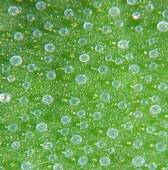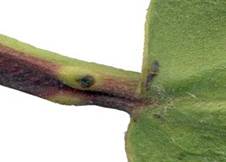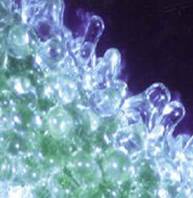
|
||||||
Stress Management :: Salinity |
||||||
MECHANISM OF SALT TOLERANCE I. Avoidance: Avoidance is the process of keeping the salt ions away from the parts of the plant where they are harmful. 1. Salt Exclusion II. Tolerance Osmotic adjustment Hormone synthesis - ABA stress hormone, hardens plants against excess salts Salt exclusion The ability to exclude salts occurs through filtration at the surface of the root. Root membranes prevent salt from entering while allowing the water to pass through.The red mangrove is an example of a salt-excluding species. Salt excretion/extrusion Salt excreters remove salt through glands or bladders or cuticle located on each leaf. Salt Dilution By dilution of ions in the tissue of the plant by maintaining succulence.Plants achieve this by increasing their storage volume by developing thick, fleshy, succulent structures Succulence is mainly a result of vacuoles of mesophyll cells filling with water and increasing in size. This mechanism is limited by the dilution capacity of plant tissues
Compartmentation of ions Organ level - high salts only in roots compared to shoots especially leaves .At cellular level- high salts in vacuoles than cytoplasm thus protecting enzymes SALT TOLERANCE IN CROP PLANTS1. Salt tolerance of cereal cropsMost of the major cereal crops exhibit high tolerance to soil salinity. In this group are sorghum, wheat, triticale, ripe, oats and barley. Only exceptions are corn and rice. All cereals tend to follow the same sensitivity or tolerance pattern in relation to their stage of growth. Seeding or early vegetative stage appears to be the most sensitive. With subsequent stages showing increased tolerance. The phenomenon has been reported for sorghum, wheat, barley, corn and rice. Salt stress can have a significant effect on the developmental process. In the first phase Leaf and spikelet primordial are initiated, leaf growth occurs and tiller buds are produced at the axils of the leaves. High salinity at this time reduces the no. of leaves per cubic the no. of spiklets per spike and no. of tillers per plant. In the Second phase Tillers grow, main stem and tiller culms elongate and the final no. of florets is set. Salinity stress during this phase affects tiller survival and reduces the no. of functional floats / spikelets. This phase ends with anthesis. During the final phase Carpet fertilization and grain filling occur during the final phase. At this time, salinity affects seed number and seed size. The effect of salinity on spikelet and tiller number established during phase I has a greater influence on final seed yield than the effects exerted on yield components in the latter two phases. 2. Salt tolerance of vegetable crops Vegetable crops tend to fall into more sensitive salt – tolerant categories. The only notable exceptions are asparagus and red beet under marginal conditions of salinity, the growth of many vegetables is stunted without showing visible injury symptoms. At high salinity levels, some vegetables exhibit pronounced injury symptoms in the later stages of growth. Bean leaves develop a marginal chlorosis-necrosis with an upward cupping of the leaves. Onions have also been shown to develop a leaf necrosis. In addition to growth suppression, some vegetable crops exhibit symptoms of nutritional imbalance of deficiency. Some lettuce cultivars develop calcium – deficiency symptoms when SO4 level in the soils is too high. Excess calcium may restrict the uptake of potassium which may be a factor in reduced yield of bean and carrot. Vegetable crops produced on saline soil are not of prime market quality. For e.g. smaller fruit size of tomato and pepper sand reduced petiole length of early misshapen potatoes. But in carrots and asparagus, the flavor is enhanced by a measurable increase in sugar content. When grows under saline conditions. Similarly in tomatoes total soluble solids is significantly increased as salt stress is increased. 3. Salt tolerance of fruit trees and vine crops Most fruit trees are relatively sensitive to salinity. Stone fruits, citrus and avocado have all shown specific sensitivity to foliar accumulations of Cl- and Na-. The accumulation of these ions to harmful levels contributes to the reduction in tree growth and fruit yield. Chloride toxicity in woody plants is more severe and is observed on a wide range of species than Na+ toxicity. The initial symptoms of excess chloride accumulation are leaf tip necrosis developing into marginal necrosis. With citrus, a chlorosis and bronzing of the leaves occur without a well defined necrosis. As Cl- continues to accumulate, the effects become more severe with premature leaf drop, complete defoliation, twig dieback in extreme cases death of the vine. Injury by Na+ can occur of concentration as low as 5 mol m-3 in the soil solution. The injury symptoms are characterized as tip, marginal or interveinal chlorosis. Initially, Na+ is thought to be retained in sap wood of the ---. With the conversion of sap wood to heartwood, Na+ is released and then translocated to the leaves causing leaf burn. This may explain why stone fruits and grapes appear to be more sensitive to salinity as the plants grow older. With succeeding years, the Cl- and Ha+ accumulate were rapidly in the leaves, causing leaf burn to develop earlier and with severity. 4. Salt tolerance of ornamentals, trees and flowers A limited number of floricultural plants have been tested for salt tolerance. Chrysanthemum, carnation and stock are considered moderately tolerant to salt stress. Aster, poinsettia, gladiolus, gerbera, amaryllis, and African violet are considered somewhat sensitive. In woody ornamentals and trees, the type of injury is similar to damage recorded for fruits trees and vines. Related links: http://www.plantstress.com/Articles/salinity_m/salinity_m.htm Source: Dept. of Crop Physiology, TNAU, Coimbatore Dept. of Biotechnology, CPMB, TNAU, Coimbatore |
||||||
| © All Rights Reserved. TNAU-2016. |
||||||


